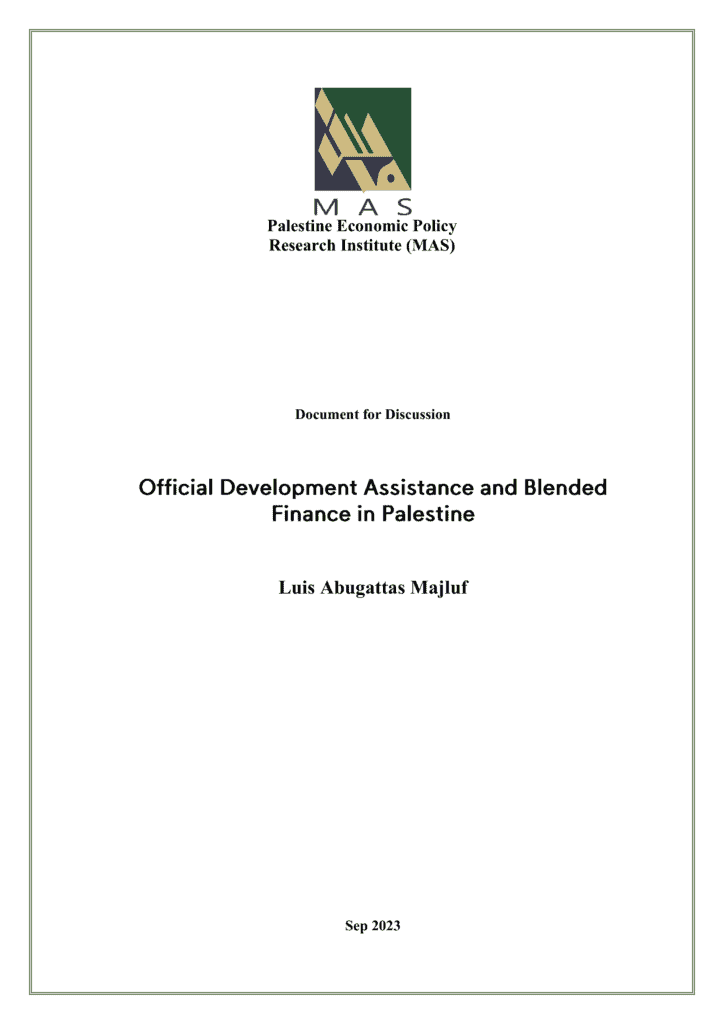ACT Alliance EU commissioned the Palestine Economic Policy Research Institute (also known as MAS) to conduct research into the use of blended finance in the EU’s official development assistance to Palestine. Mr Luis Abugattas Majluf, an economist, led the research and authored a discussion paper titled “Blended Finance and Official Development Assistance in Palestine”.
Executive summary
Through the examination of secondary sources and available data, this report delves into the concept of blended finance, its increasing role in official development assistance (ODA) and its impact in fostering sustainable development in Palestine.
While Palestine has received substantial ODA, its impact on economic development remains limited due mainly to the Israeli occupation. In addition, while aid has sustained the Palestinian Authority (PA), most funding has been directed toward budget support rather than development.
Challenges in ODA trends and blended finance
Of late, ODA inflows are declining both in absolute terms and as a percentage of Gross National Income (GNI). Meanwhile, blended finance, a significant and growing part of aid, has yet to undergo a comprehensive assessment.
While institutional definitions of blended finance vary, its objective primarily focuses on mitigating project risks to increase commercial investment. Essentially, blended finance aims to strategically combine different types of development finance to attract additional resources for sustainable projects.
The first section of this report outlines blended finance concepts, emphasising their distinctiveness from other financial interventions and their role in mobilising significant capital globally. It recognises that assessing its impact both in Palestine and generally, is complex due to methodological challenges and limited project-specific data.
The subsequent sections focus on evaluating the financial landscape in Palestine and reveal significant financial exclusion and a disparity between credit demand and supply in the private sector.
Challenges in Palestinian Financial Landscape
As underlined in the report, data limitations and low credit demand amidst available resources pose challenges for evaluating blended finance effectiveness in Palestine. The larger geopolitical context, including occupation-related constraints, raises questions about the efficacy of additional financial injections.
Moreover, the Palestinian banking sector, while stable, is highly concentrated with two large banks having a joint market share of close to 50 percent. Diversification would help to mitigate risks. Financial exclusion persists at a high level, both for private individuals and for businesses, requiring initiatives to increase general access to banking services.
Despite resource availability, there is minimal demand for credit among firms and individuals. Overreliance on public sector credit could be crowding out private sector investments, demanding a rebalance. The role of microfinance institutions, though growing, requires re-evaluation to achieve broader financial inclusion.
Report recommendations
The report recommends sample-based assessments to gauge the true impact of blended finance, advocating for technical assistance in investment project preparation over solely providing credit facilities. Employing a mix of grants, equity investments, and technical assistance might yield better results given Palestine’s unique challenges, rather than relying solely on traditional blending methods like guarantees.
It goes on to recommend a greater focus on funding development projects and programmes, case-by-case evaluation of banks’ and microfinance institutions’ use of blended finance, improvements in data collection related to blended finance approaches, and greater consideration of political factors and institutional limitations when designing aid strategies, to address the broader geopolitical challenges that influence development outcomes.
